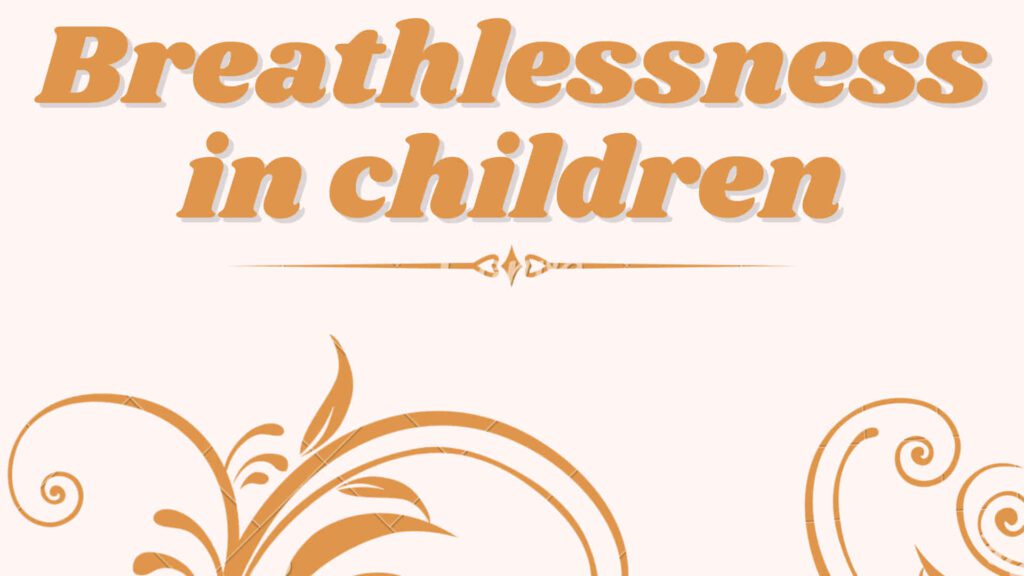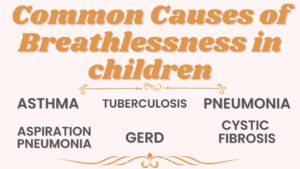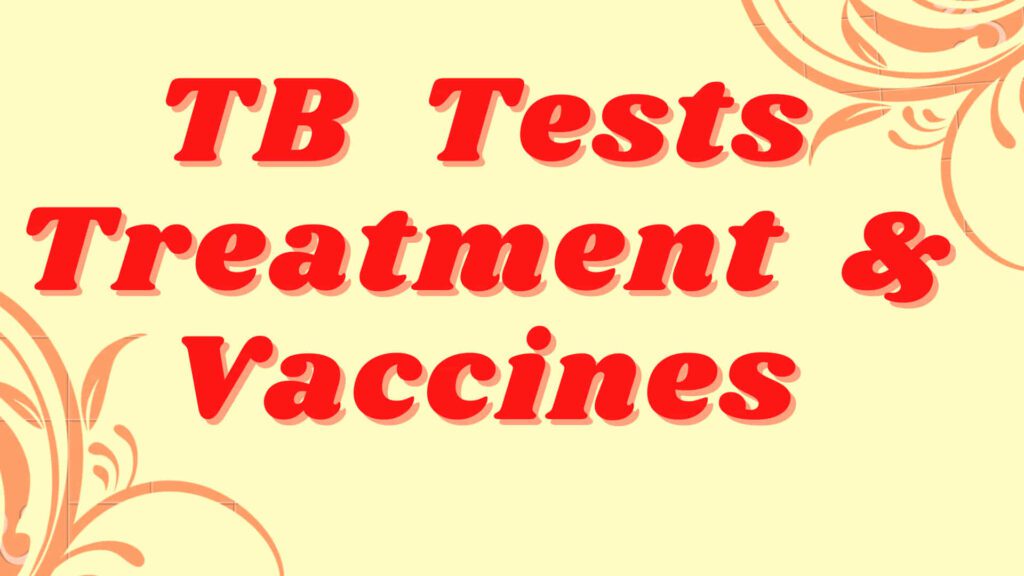These are the Commonest Problems of Shortness of Breath in a kid at rest
- ASTHMA
- TONSILLITIS
- CYSTIC FIBROSIS
- ASPIRATION PNEUMONIA
- PNEUMONIA (BACTERIAL OR VIRAL)
- PULMONARY TUBERCULOSIS
- GASTRO-OESOPHAGEAL REFLUX (GOR)
Now, Below we have defined all of these diseases in detail
Table of Contents
Asthma: The most common cause of Shortness of breath in children
It is one of the Common causes of Shortness of Breath at rest in Children. Asthma is a chronic inflammatory condition of the airways that affects children and occurs due to the activation of mast cells.
Common triggers in childhood
- Viral upper respiratory tract infections (most common)
- Exercise
- Emotion
- Cold weather
- Smoking
Some children can have recurrent virus-induced wheezing, but no symptoms in between
The Early warning signs include
- Runny nose
- Cough
- Dark circles
Examination Findings in a child with asthma are
- Tachypnoea: High Breathing rate
- Hyperinflation: increased inspiration: Bloated chest
- Tracheal tug (downward pull of trachea and larynx)
- Use of accessory muscles of respiration eg. Neck muscles.
- Barrel-shaped chest (in severe chronic asthma)
Treatment of Acute Asthma Attack
- Firstly Assessment of the airway,
- Then Breathing,
- Then Circulation
- Give Salbutamol 10 puffs of MDR via a spacer device: This can be repeated half-hourly until the cessation of symptoms.
- Children with severe distress or who are unconscious should be given nebulized salbutamol (2.5 mg For less than 5 years of age and 5 mg in patients above 5 years).
- Oral Prednisolone can also be given 2 mg/kg/day
- Reassessment
Tonsillitis
Inflammation of the tonsils (Tonsils are two oval-shaped Lymphatic tissues present at the sides of the back of the throat)
The commonest cause of Tonsilitis: Streptococcus pyogenes.
Saltwater gargle, Fluid intake, or Intravenous fluids can be given to manage Tonsilitis.
Signs and Symptoms of Tonsillitis
- Difficulty in swallowing,
- Sore throat
- Tender lymph nodes
- Red and Sandpaper-like soft palate
Cystic Fibrosis
Cystic fibrosis is a very common genetically linked condition in the Caucasian population. Yes this is the same disease that we saw in the movie Five Feet Apart.
It is inherited from the parents of the child (as an autosomal recessive disease)
The Cause of Cystic Fibrosis is the mutations (from the parents) on the CF gene which (makes CFTR protein)
The CF gene codes for a protein: the Cystic Fibrosis Transmembrane Regulator (CFTR). This functions in the transportation of molecules, such as chloride across the membranes of cells in the lungs, liver, pancreas, digestive tract, reproductive tract, and skin. Mutations cause defects in salt and water absorption across cells.
The CF-Defected lung is more susceptible to infection From S. aureus, Pseudomonas, etc hence causing recurrent pneumonia and infections.
Symptoms of Cystic Fibrosis
- Children with frequent chest infections due to susceptible respiratory tract to infections.
- Clubbing of Finger
- Chest deformities.
- Breathless may be present occasionally
- Crackles and Wheezing sounds from the chest.
- Abdominal distension and malabsorptive signs.
Diagnosis
The gold standard for the diagnosis of CF is the Sweat Test. People with CF have a high level of chloride in their sweat, This Chloride can be picked up and give positive results in the test.
Sweat test
The doctor will take the sample of your sweat (Pilocarpine is administered to help you sweat) and then the doctor will measure the amount of sodium and chloride present. In children, a sweat chloride concentration of more than 60 mmol/kg is a confirmatory diagnostic of CF.
Complications of Cystic Fibrosis
Cystic Fibrosis Gut and Liver Disease. Cystic Fibrosis can also cause Diabetes but it is rare.
Aspiration Pneumonia
This is a lung infection where the contents of the Mouth (Bacteria or Food particles) spill into the Lungs causing cough, fever, and irritant pneumonia.
These can occur in children with Cerebral palsy(most common) Head injury or Coma because these children have lost their protective reflexes such as Gaging and Coughing (due to decreased brain activity)
Signs and Symptoms of Aspiration Pneumonia
- Coughs and chokes during feeds
- Breathlessness
- Fever
- Chronic cough
- Chest pain (more commonly to the right side)
Recurrent aspiration is definitely not healthy for your lungs.
Investigation and lab tests of Aspiration Pneumonia
The doctor can order a barium swallow test to look for reflux into your lungs.
Pneumonia
It is inflammation of the Lung parenchyma that often occurs as a result of bacterial or viral infection.
Viral Pneumonia
Respiratory syncytial virus (RSV) is Characteristically the most important cause of viral infection of lungs in infants and children, worldwide. It is most prevalent in the winter months.
Common symptoms of Viral Pneumonia are
- Fever
- Coryza (inflammation of mucous membranes in the nose)
- Cough
- Wheezing
- Breathing difficulty and Breathlessness at rest
Premature infants, those with neuromuscular disease, or congenital heart disease are more at risk of developing Viral Pneumonia
Bacterial Pneumonia
The most common bacterial pathogen is Streptococcus pneumonia. Others include Mycoplasma pneumoniae, Hemophilus influenza
Signs and symptoms of Bacterial pneumonia
- Fever, and Rapid breathing
- The child can be Breathless at rest
- Cough
Pulmonary Tuberculosis
Tuberculosis (TB) is caused by infection with Mycobacterium tuberculosis bacteria. TB is most common in the developing parts of the world and areas of poverty and deprivation.
TB can be spread by inhaling respiratory secretions from an infected person During cough or sneeze.
Signs and symptoms of TB
- Cough
- Night sweats
- Weight loss
Young children are particularly at risk of TB meningitis, which means the inflammation of the coverings of the brain
GASTROESOPHAGEAL REFLUX DISORDER (GERD)
This is a condition in which stomach contents reflux upwards into the esophagus. It is accompanied by some discomforting signs and symptoms as follows:
Signs and symptoms
- Heart-Burn: Upper Stomach pain
- Recurrent Colourless vomiting
- Weight gain (when the reflux is severe)
- Chronic cough
- Wheezing
- Aspiration: Stomach contents into the lungs
- Asthma
Children with severe cerebral palsy and coma are more prone to chest problems due to muscle weakness (hypotonia) and ineffective cough.





Pingback: D Dimer test in COVID? Normal range, Symptoms and Procedure - MG